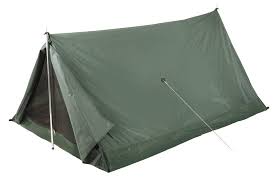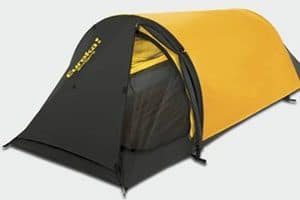Pyramid
This simple tent structure is made up of a singular tent pole supporting a tent cover, which is pulled taunt over the pole and secured to the ground surrounding.

Photo Source: ilpentolino.com
Avian
Similar in structure to the pyramid style, avian style tents are comprised of one or multiple straight poles supporting a tent cover. Pyramid and avian models can be limiting because the poles obstruct the inner area of the tent. They are best for short use, mild weather conditions or instances where quick shelter is needed.

Photo Source: pilipinasmountains.blogspot.com
A-Frame
Typically, these tents consist of two poles at each end to form an A-shape, with a single pole running down the center. A traditional A-frame model can be limiting in terms of size and stability because of the sloped sides. Alternatively, a modified A-frame tent consists of curved poles instead of straight, ultimately providing better stability and increased headspace in the interior. Modified models also tend to include a rainfly.

Photo Source: glacierwaterton.com
Tunnel
Tunnel tents have two or more poles along the width of the tent, providing good usable height along the centre line. Because they are pitched low to the ground, they stand up well against harsh winds.

Photo Source: outlandian.com
Hoop
Hoop tents consist of arched frames, which lend shape and stability throughout the structure. The arched shape of the roof allows for snow and rain to slide right off the tent. Hoop tents are lightweight and small when packed up, making them ideal for backpackers.

Photo Source: campingroadtrip.com
Wedge
The wedge tent is a modified version of the aforementioned hoop tent, utilizing two intersecting hoops.

Photo Source: ahalife.com
Dome
Dome tents are easy to pitch, structurally stable, and spacious, making them a popular choice for families and groups. These tents are usually made up of two to three poles intersecting to create the roof.

Photo Source: trailspace.com
Other factors to consider when purchasing a tent:
- Material
Most tents are made of nylon, canvas or polyester. Nylon is the lightest of the bunch, designed for mild weather conditions; canvas is heavy but durable; polyester stands up well to heat and persistent sunlight.
- Freestanding or fixed
Theoretically, freestanding tents support themselves, meaning that when fully pitched, they can support themselves and be physically moved if needed. Freestanding tents tend to be more popular than the alternative: fixed tents. A fixed tent requires stakes and guylines, which secure the structure to the ground, in order to support itself. Freestanding tents often require stakes and guylines as well, so that a strong wind doesn’t cause them to shift after they’ve been pitched.
- Special features and hybrids.
Besides the aforementioned seven tent types, there are tents available on the market which surpass basic use. Examples of these include hybrid tents, which combine desirable features from the existing tent types, suspended models or safari tents.
Latest posts by Canadian Home Trends (see all)
- Dining Room Design Tips - July 15, 2025
- Practical Luxury in Forest Grove - July 15, 2025
- The Hidden Value of Great Design - July 15, 2025






